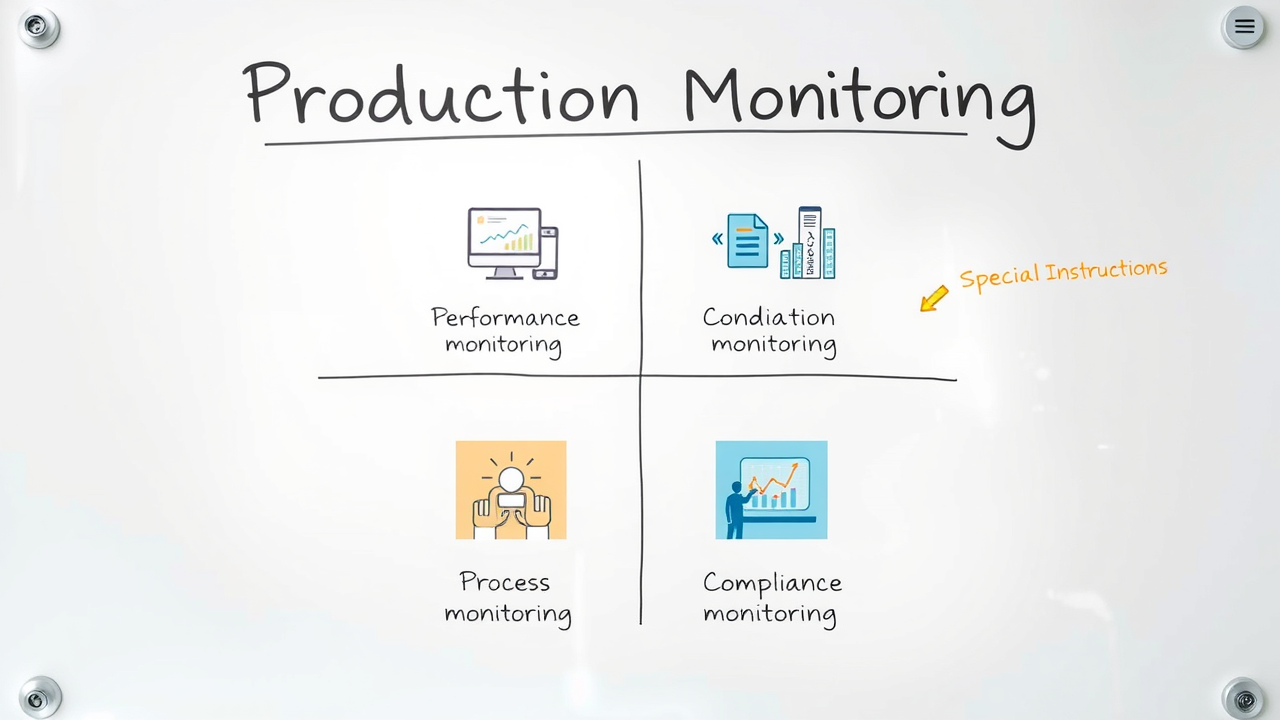Did you know that manufacturers who embrace real-time production monitoring software can increase their productivity by up to 30%? That’s no small leap—it’s a competitive edge your shop floor can’t afford to miss. Suppose you’re wrestling with delays, inefficiencies, or bottlenecks in your production line. In that case, this guide provides the practical and data-driven solutions you need to transform your manufacturing operations from guessing games into growth machines.
Unlocking Success: Why Production Monitoring Is Non-Negotiable
‘Manufacturers who adopt real-time production monitoring software increase their productivity by up to 30%.’ — Industry Week 2023
In today’s fiercely competitive landscape, production monitoring isn’t just a nice-to-have—it’s the foundation for operational excellence and sustainable profitability. Companies that leverage advanced production monitoring software gain live visibility across every step on the plant floor, from machine monitoring to output tracking. This immediate insight enables smarter decisions, lets you reduce downtime and waste, and supports continuous improvement across your entire manufacturing process.
Failing to prioritize real-time monitoring systems can mean missed deadlines, escalating costs, and lost market share. Successful production monitoring integrates seamlessly with quality control and OEE software, aligning every stakeholder with performance goals. By making informed decisions based on timely production data, you’re empowered to hit delivery targets, enhance quality, and maximize output, all while keeping your workforce engaged and motivated on the shop floor.
The Startling Costs of Poor Production Monitoring

Without effective production monitoring systems, manufacturers suffer from unexpected downtimes, material wastage, and product defects that eat directly into profit margins. Nested inefficiencies—like workflow bottlenecks or suboptimal machine monitoring—often go unnoticed until it’s too late. Valuable raw materials are lost to the scrap heap, while unchecked production lines operate below capacity.
The financial fallout is real: increased operational costs, missed customer commitments, and a production process that lags behind agile competitors. A lack of reliable data collection prevents organizations from implementing continuous improvements or from determining the true ROI of capital investments. As a result, shop floor teams can’t confidently make informed or timely adjustments, which perpetuates a cycle of inefficiency.
Defining Production Monitoring: What You Need to Know
At its core, production monitoring is a proactive management process that involves real-time tracking, analysis, and intervention throughout the manufacturing lifecycle. Using digital monitoring software, teams can oversee everything from equipment effectiveness and operator performance to quality control and order status—enabling quick responses when issues emerge.
A robust production monitoring system captures and centralizes data from machines, sensors, and workforce inputs directly on the plant floor. This transparency empowers organizations to react quickly, continuously improve, and maintain compliance—all essential ingredients for meeting customer demands while maximizing efficiency across production lines.
Production Monitoring Versus Time Production Monitoring
While the term production monitoring covers the full range of systems used to oversee manufacturing operations, time production monitoring specifically focuses on measuring cycle times, setup times, and periods of activity or downtime for both equipment and labor. This granularity is crucial for high-volume environments, where even small time savings aggregate into significant cost reductions and productivity improvements.
Put simply, time production monitoring is the high-resolution lens through which manufacturers can view performance bottlenecks in the production process. By leveraging both comprehensive production monitoring software and specialized time production monitoring tools, managers can zero in on operational chokepoints, drive continuous improvement, and ultimately, transform real-time insights into actionable business value.
What You’ll Learn About Production Monitoring
Benefits of real time production monitoring and time production
How to leverage monitoring software and production monitoring software
Key components of a successful monitoring system
Strategies for optimizing production efficiency and quality control
Roadmap to implementing continuous improvement in your production line
This article equips you with the knowledge and tools needed to unlock the full potential of your production line, harnessing the power of real-time production monitoring to drive measurable results.
Production Monitoring: Fundamentals and Best Practices

Understanding Production Monitoring Systems
Modern production monitoring systems are the backbone of intelligent manufacturing. These systems use sensors and connected devices to collect real time data from shop floor machines, workstations, and operators—painting a clear, live picture of your production process. Integrating seamlessly with OEE software and other tools, effective monitoring platforms offer insight into overall equipment effectiveness, downtime, labor utilization, and throughput.
Organizations rely on production monitoring software to digitize every aspect of manufacturing operations. From raw material inputs to finished product outputs, the best systems enable scheduling, automated data collection, and actionable notifications—all within one connected monitoring system. This unprecedented visibility reduces waste, accelerates decision-making, and makes it possible to continuously improve.
Types of Production Monitoring: A Deep Dive
There’s no one-size-fits-all solution for production monitoring. Instead, manufacturers deploy a combination of strategies that fit specific needs—like reducing downtime, optimizing product quality, or ensuring regulatory compliance. The four main types, each with dedicated monitoring tools and software, are explored below.
Understanding these types—from performance monitoring to process monitoring—is critical for layering multiple approaches within a unified and effective production monitoring system. Each type leverages data insights to support targeted improvements throughout your manufacturing process.
Four Main Types of Production Monitoring |
|||
Type |
Overview |
Key Features |
Use Cases |
|---|---|---|---|
Performance Monitoring |
Tracks key metrics like throughput, cycle time, downtime, and equipment effectiveness in real time. |
Live dashboards, OEE, downtime/root cause analytics |
Optimize output on assembly lines; identify bottlenecks |
Condition Monitoring |
Monitors machine health using sensors that report on vibration, temperature, or lubrication. |
Predictive alerts, maintenance scheduling, sensor analytics |
Prevent machine failures; plan proactive maintenance |
Process Monitoring |
Analyzes production process steps, control parameters, and deviations from setpoints. |
Control charts, trend monitoring, SPC integration |
Ensure product quality and process consistency |
Compliance Monitoring |
Verifies that environmental, safety, and regulatory standards are met. |
Audit trails, checklists, reporting automation |
Support ISO, FDA, and safety compliance |
Critical Tasks in Monitoring Production

The most critical tasks in production monitoring revolve around capturing key metrics and making swift adjustments. With real-time machine monitoring, operators and managers can identify deviations the moment they occur—protecting your production line and your bottom line. These tasks include continuous tracking of equipment effectiveness, quality metrics, cycle times, and the flow of raw materials across production stages.
Another essential responsibility is correlating production data with operational targets. That means blending automated alerts for downtime events with manual checks on the shop floor. Strong monitoring systems also enable traceability and post-shift reviews, ensuring any improvement opportunities are identified and acted on. Every successful monitoring program is built on proactive, data-driven engagement—empowering your team to continuously improve and keep pace with shifting demands.
Integrating Production Monitoring with Quality Control and Machine Monitoring
Integrating production monitoring with quality control closes the loop between throughput analytics and end-product standards. Real-time data from machine monitoring reveals early signs of equipment issues or deviations that could compromise quality, allowing corrective action before defects multiply. This synergy is fundamental to maximizing production efficiency and achieving operational excellence.
Effective monitoring software coordinates these functions seamlessly, centralizing data streams and permitting direct lines of communication among production, maintenance, and quality assurance teams. Result: you reduce waste, continually improve product reliability, and make informed decisions on both preventative maintenance and quality improvements, all within the same digital ecosystem on the plant floor.
Leveraging Production Monitoring Software for Real Time Data and OEE
Today’s leading production monitoring software delivers far more than retrospective reports. Real-time dashboards visualize live KPIs, automate production tracking, and offer actionable insights into OEE (Overall Equipment Effectiveness), revealing exactly where to focus improvement efforts. Seamless integration with OEE software and machine monitoring enables top-performing factories to hit ambitious output targets without sacrificing quality.
By leveraging immediate access to production data across all shifts, manufacturers can react the moment a problem arises—whether it’s a machine faltering, an operator error, or a supply chain hiccup. This agility enables shop floors to operate closer to capacity, reduce downtime, and achieve continuous improvement that’s visible in both efficiency metrics and your bottom line.
List: The Five Steps in a Robust Production Process
Planning: Develop forecasts, resource allocation, and production schedules to set your production strategy and prioritize customer needs.
Scheduling: Translate plans into task-level production timelines, ensuring resource, labor, and machine readiness.
Actual Production: Execute work orders on the shop floor, using machine monitoring, workforce management, and production tracking tools.
Quality Control & Continuous Improvement: Apply quality control checks, analyze production data, and implement lessons learned to continually improve product outcomes.
Post-Production Tracking & Analysis: Measure performance, gather customer feedback, and refine future plans with data-driven insights.
Effective production monitoring supports each of these five steps, streamlining workflows and ensuring your manufacturing process meets—and exceeds—business goals.
Production Monitoring Software: Solutions, Features, and Time Production Tracking
Key Features of Leading Production Monitoring Software

The most successful production monitoring software streamlines complex manufacturing operations through intuitive dashboards, automated alerts, and flexible integration capabilities. Key features include real-time KPI tracking, OEE calculators, customizable analytics, seamless machine monitoring connections, and easy workflow automation for shop floor activities.
Additionally, leading monitoring software supports mobile access, unlimited data storage, and advanced reporting—ensuring your team can track production efficiency and spot optimization opportunities from anywhere. Comprehensive audit trails and compliance features make it simple to maintain standards and certifications, while user-friendly interfaces encourage adoption and consistent engagement across shop floor roles.
Real Time Production Monitoring: Data Visibility in Action
The real advantage of modern production monitoring comes from live data visibility. Managers can dive into current production line status, monitor output per shift, and identify bottlenecks—and they can do it all in real time. Automated visualizations and reports deliver instant feedback, accelerating decisions and driving down response times to unplanned events.
Real-time data collection also helps teams reduce waste by revealing inconsistencies the moment they appear. Corrections can be issued mid-shift instead of waiting for end-of-day reviews. This direct connection between live events and management response is what drives continuous improvement and operational excellence in leading manufacturing operations.
OEE Software: Maximizing Production Efficiency and Output
Overall Equipment Effectiveness (OEE) is a critical metric for any manufacturer determined to improve product quality while maximizing throughput. Integrating OEE software with your production monitoring systems creates a unified digital command center where downtime, cycle times, and defect rates are tracked in real time.
Easy-to-read dashboards break down every aspect of equipment performance and enable targeted interventions. By focusing on OEE, production teams achieve better machine utilization, identify underperforming assets, and implement continuous improvement practices that carry over all the way to finished-product delivery.
Comparing Monitoring Software: Which Solutions Stand Out?
With dozens of production monitoring software options, it’s essential to select solutions that align with both your shop floor’s current needs and your company’s future growth ambitions. Top vendors are distinguished by their ease of integration, user-centric dashboards, analytics capabilities, and proven results in real manufacturing environments.
Leading choices typically support connectivity with legacy gear, robust API infrastructure, and scalable licensing sizing for enterprise expansion. Below, compare some of the best-known providers and what sets them apart.
Top Production Monitoring Software & Vendor Comparison |
|||
Vendor |
Key Features |
Ideal Use Case |
OEE/Real-Time Support |
|---|---|---|---|
Dataomix |
Real-time dashboards, OEE integration, legacy machine support |
Flexible for both small shops and enterprise rollouts |
Yes |
MachineMetrics |
Predictive analytics, IIoT sensor integration, downtime insights |
Automated machine monitoring, predictive maintenance |
Yes |
Prodsmart by Autodesk |
Workflow automation, mobile access, analytics |
Agile production environments, process monitoring |
Yes |
Samsara |
Compliance, environmental tracking, supply chain analytics |
Regulatory-heavy manufacturing, logistics integration |
Limited |
UpKeep |
CMMS focus, maintenance requests, work order tracking |
Asset maintenance and condition monitoring |
Partial |
Driving Continuous Improvement with Production Monitoring
Building a Culture of Real-Time Data and Quality Control
A successful production monitoring strategy is about more than adopting the right software—it’s about embedding a culture where data-driven quality control is the norm. When real-time metrics guide daily decisions, teams become more engaged, proactive, and committed to excellence. This cultural alignment is what transforms technology investments into measurable performance gains on the shop floor.
Continuous improvement must be deliberate, with regular reviews of production data, open communication about challenges and wins, and a willingness to try iterative process changes. As technology and people work in tandem, your organization can achieve greater agility, resilience, and customer satisfaction.
Case Study: How Production Monitoring Transformed a US Manufacturer

Consider a Midwest OEM that, within six months of deploying a modern, data-driven production monitoring system, cut its scrap rate by 23%. Real-time dashboards empowered operators to act on production data immediately, preventing recurring defects, and enabling supervisors to focus resources where they were needed most.
‘We reduced our scrap rate by 23% in six months leveraging a data-driven monitoring system.’ — Plant Manager, Midwest OEM
This case exemplifies how transformational gains are possible on any production line—provided companies commit to real-time feedback, empower their workforce, and integrate their monitoring systems with quality and machine monitoring tools. The outcome: higher throughput, lower costs, and a sustainable edge in the marketplace.
People Also Ask: Production Monitoring Explained

What is the meaning of production monitoring?
Production monitoring refers to the systematic tracking, analysis, and management of production processes in real time to maximize efficiency, quality, and profitability. Using monitoring software, organizations gain visibility into every stage of production, enabling prompt decision-making and continuous improvement.
What are the 4 types of monitoring?
The four main types of monitoring are performance monitoring, condition monitoring, process monitoring, and compliance monitoring. Each type leverages production monitoring software to collect actionable data and optimize specific areas of the production line.
What is a key task in monitoring production?
A key task in production monitoring is real-time tracking of machine performance and production output. This allows for immediate identification of inefficiencies or deviations, supporting timely interventions and continuous improvement.
What are the 5 steps in the production process?
The five steps include planning, scheduling, actual production, quality control, and post-production tracking. Effective production monitoring is essential across each step to maintain optimal output and quality.
FAQs: Optimize Your Production Monitoring Strategy
How do real-time production monitoring systems integrate with quality control?
Real-time monitoring systems collect and share live data with quality control teams, enabling immediate detection of defects or process deviations. This speeds up corrective actions, strengthens compliance, and drives overall product quality.Can production monitoring software work with legacy machines?
Yes. Many modern systems use IoT adapters and custom interfaces to capture data from older equipment, ensuring comprehensive monitoring across both new and existing assets.What KPIs should I track in production monitoring?
Key KPIs include cycle time, downtime, scrap rate, throughput, yield, and OEE. Tracking these empowers your team to identify trends and take strategic action.How does time production monitoring improve workflow?
By analyzing actual versus target cycle times and identifying downtime events, time production monitoring helps pinpoint bottlenecks. This supports better scheduling, resource management, and on-time delivery.
Key Takeaways for Better Production Monitoring
Production monitoring is critical for maximizing efficiency, quality, and profitability.
Modern monitoring software enables real-time feedback and data-driven decisions.
Integration with OEE software and quality control supports holistic process improvement.
Continuous improvement should be a central focus of your production monitoring strategy.
Conclusion: Data-Powered Production Monitoring—Don’t Get Left Behind
Why Advanced Production Monitoring is the Backbone of Smart Manufacturing
Advanced production monitoring transforms manufacturing operations by empowering real-time insight, boosting efficiency, and improving product quality—making it the backbone of today’s smart factories.
To deepen your understanding of production monitoring and its critical role in manufacturing efficiency, consider exploring the following resources:
“A Comprehensive Guide to Production Monitoring” (safetyculture.com)
This guide delves into the significance of real-time production monitoring, detailing methods such as manual monitoring, IoT integration, and Manufacturing Execution Systems (MES). It also outlines best practices for effective implementation, including setting clear objectives and leveraging predictive analytics.
“Production Monitoring: Boost Factory Efficiency & Performance” (cideon.com)
This article highlights the advantages of implementing production monitoring systems, emphasizing real-time monitoring, key performance indicators (KPIs), and predictive maintenance. It discusses how these systems can enhance data collection, error detection, and maintenance management to improve overall factory performance.
By engaging with these resources, you’ll gain valuable insights into the methodologies and benefits of production monitoring, equipping you with the knowledge to optimize your manufacturing processes effectively.
 Add Row
Add Row  Add
Add 




Write A Comment